Nagorno-Karabakh Autonomous Oblast
| Nagorno-Karabakh Autonomous Oblast | |||||||||||
|---|---|---|---|---|---|---|---|---|---|---|---|
| Autonomous oblast of Azerbaijan Soviet Socialist Republic | |||||||||||
| 1923–1991 | |||||||||||
 | |||||||||||
| Capital | Stepanakert | ||||||||||
| Area | |||||||||||
• | 4,388 km2 (1,694 sq mi) | ||||||||||
| Population | |||||||||||
• | 162,181 | ||||||||||
| • Type | Autonomous Oblast | ||||||||||
| History | |||||||||||
• Established | 7 July 1923 | ||||||||||
• Abolished | 26 November 1991 | ||||||||||
| |||||||||||
| Population source:[1] | |||||||||||
The Nagorno-Karabakh Autonomous Oblast[2] was an autonomous oblast within the borders of the Azerbaijan Soviet Socialist Republic, mostly inhabited by ethnic Armenians. It was divided into five raions or administrative divisions:
- Mardakert District (NKAO)
- Martuni District (NKAO)
- Shusha District (NKAO)
- Askeran District (NKAO)
- Hadrut District (NKAO)
History

According to Robert Service, in 1921 Joseph Stalin, acting the Commissar of Nationalities, forced the communist party Caucasian bureau to transfer Nakhichevan Autonomous Soviet Socialist Republic and Karabakh from nominally independent Armenia to Soviet Azerbaijani control to try to placate Turkey to join with Russia against the Western Powers. Had Turkey not been an issue, Stalin would probably have left Karabakh under Armenian control.[3]
As a result, the Nagorno-Karabakh Autonomous Oblast was established within the borders of the Azerbaijan Soviet Socialist Republic on July 7, 1923. According to Karl R. DeRouen, it was created as an enclave so that a narrow strip of land would separate it from the Armenian SSR.[4] According to Audrey L. Altstadt, the borders of the oblast were drawn to include Armenian villages and to exclude Azerbaijani villages, so that the area would have an Armenian majority.[5]
Military conflict

The conflict between the Armenians in the oblast and the government of the Azerbaijan SSR broke out in 1987. The fighting escalated into the Nagorno-Karabakh War by the end of 1991. On November 26, 1991, the parliament of the Azerbaijan SSR abolished the autonomous status of the oblast. Its internal administrative divisions were also abolished, and its territory was split up and redistributed amongst the neighboring administrative raions of Khojavend, Tartar, Goranboy, Shusha, and Kalbajar[6] In response, the majority Armenian population of the oblast declared their independence as the Nagorno-Karabakh Republic. Today, most of the territory of the former oblast is under the control of the Artsakh Defense Army.
Current status
Today, the area of the former NKAO is under de facto control of the wider Republic of Artsakh. However, the republic has limited international recognition. Azerbaijan considers the former oblast to be a de jure part of that state.[7] Azerbaijan dissolved the oblast as an entity of Azerbaijan on November 26, 1991 by the Law on Abolishment of Nagorno-Karabakh Autonomous Oblast.
See also
References
- ^ (in Russian) НАГОРНО-КАРАБАХСКАЯ АО (1979 г.)
- ^ Template:Lang-ru; Azerbaijani: Дағлыг Гарабағ Мухтар Вилајәти, ДГМВ / Dağlıq Qarabağ Muxtar Vilayəti, DQMV; Template:Lang-hy / Lernayin Ġarabaġi Inknavar Marz, LĠIM
- ^ Robert Service, Stalin: a Biography (Cambridge: Harvard University Press, 2006, ISBN 0-674-02258-0), p. 204
- ^ Karl R. DeRouen, Civil Wars of the World: major conflicts since World War II, Vol. 1 (2007), p. 146
- ^ Audrey L. Altstadt, The Azerbaijani Turks: power and identity under Russian rule (Hoover Press, 1992, ISBN 0-8179-9182-4, ISBN 978-0-8179-9182-1)
- ^ Svante Cornell, Turkey and the Conflict in Nagorno Karabakh: A Delicate Balance Archived June 10, 2007, at the Wayback Machine, in Middle Eastern Studies Journal Vol 34, No. 1 (London: Frank Cass Publications, January 1998), pp. 51–72
- ^ 1993 UN Security Council Resolutions on Nagorno-Karabakh, U.S. State Department website, accessed February 2007
